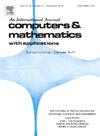非线性正则化长波方程的两种新型线性化能量守恒有限元方案
IF 2.9
2区 数学
Q1 MATHEMATICS, APPLIED
引用次数: 0
摘要
本文介绍了非线性正则化长波(RLW)方程的两种线性化二阶能量守恒方案,并利用符合有限元法(FEM)给出了无条件超近和超收敛结果。首先,通过对非线性项的巧妙分解,建立了两个线性化的二阶全离散方案。与之前的非线性方法相比,这些方案大大减少了迭代次数,提高了计算效率;此外,它们还节约了能量,并直接确保了数值解在 H1 规范下的有界性,这与之前研究中报告的 L∞ 规范有界性相比是一个进步。其次,基于 FE 解的有界性、Ritz 投影算子和线性三角形元素的高精度结果,在不限制时间步长 Δt 和空间网格大小 h 之间的比率的情况下,推导出超逼近和超收敛的误差估计值。本文章由计算机程序翻译,如有差异,请以英文原文为准。
Two novel linearized energy-conserving finite element schemes for nonlinear regularized long wave equation
In this paper, two linearized second-order energy-conserving schemes for the nonlinear regularized long wave (RLW) equation are introduced, the unconditional superclose and superconvergence results are presented by using the conforming finite element method (FEM). Initially, through a skillful decomposition of the nonlinear term, two linearized second-order fully discrete schemes are developed. Compared to the previous nonlinear approaches, these schemes significantly reduce the number of iterations and improve computational efficiency; moreover, they conserve energy, and ensure the boundedness of the numerical solution in the -norm directly, which represents an advancement over the -norm boundedness reported in prior studies. Secondly, based on the boundedness of the FE solution, the Ritz projection operator and high-precision results of the linear triangular element, the error estimates for superclose and superconvergence are derived without any restrictions on the ratio between time step size Δt and spatial mesh size h. Finally, four numerical examples are provided to confirm the accuracy of the theoretical analysis and the effectiveness of the method.
求助全文
通过发布文献求助,成功后即可免费获取论文全文。
去求助
来源期刊

Computers & Mathematics with Applications
工程技术-计算机:跨学科应用
CiteScore
5.10
自引率
10.30%
发文量
396
审稿时长
9.9 weeks
期刊介绍:
Computers & Mathematics with Applications provides a medium of exchange for those engaged in fields contributing to building successful simulations for science and engineering using Partial Differential Equations (PDEs).
 求助内容:
求助内容: 应助结果提醒方式:
应助结果提醒方式:


